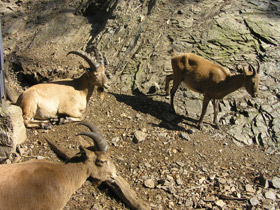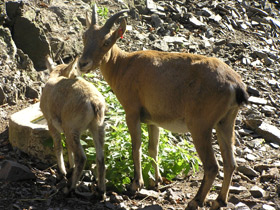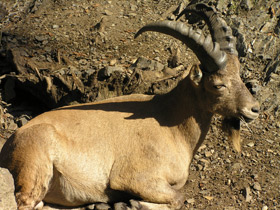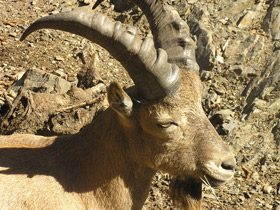The West Caucasian tur Capra caucasica
The West Caucasian tur is larger and stockier than the ibex; the body length of the male ranges from 150 to 165 cm, its shoulder height is 95 to 100 cm and weight, 65 to 100 kg, while the females are remarkably smaller. This mountain goat has relatively short, strong and curved horns reaching 75 cm in length, very short tail, and small, broad beard on the chin. The summer coat of the west Caucasian tur is generally a reddish-brown in the back, and yellowish on the underside parts of the body, while in winter it dulls to more of a greyish-brown. The species is endemic to the western part of the Great Caucasus Mountains where it is found in the narrow zone along the Russia-Georgia border, with the area of 4,500 km². Since 19th century, the range of this species has been reduced and population numbers have been declining significantly, with current estimates of the total of 10,000 wild animals. The West Caucasian tur is listed in the IUCN Red List of Threatened Species as endangered. In summer, these ungulates tend to stay in alpine regions, moving down to the forests and mountain steppes in winter. West Caucasian turs are able to move skilfully on the steepest rocky slopes where no carnivore would risk climbing. They nonchalantly walk upon icy mountain bulges at dizzy heights.
West Caucasian turs are usually active in the morning and late afternoon, while in summer they may be also active in the daytime. In the autumn and winter months, West Caucasian turs gather in herds, foraging on the slopes of southern exposition where snow cover is not deep; in summer time, they live solitary or in single sex herds, typically containing up to 15 individuals, and forage mostly on the slopes of northern exposition, moving towards glaciers or snowfields in hottest periods. West Caucasian turs are extremely cautious animals that can sense the presence of humans at the distances of a few hundred metres, and are able to see people at a distance of one kilometre. These animals usually avoid places that are commonly visited by people. If they are not disturbed, they would not move much, spending most of their time foraging or resting. West Caucasian turs tread pathways running alone the slopes and mountain ridges, and going down to water bodies or foothills. In periods of bad weather, the turs congregate in herds and stay in the shelters under overhanging rock ledges, which provide a good view of the surrounding terrain. West Caucasian turs are herbivorous feeding on wide variety of plants and grasses; in winter they eat dry grasses and sprouts. The mating season for West Caucasian turs occurs in late autumn. Males fight aggressively during this season over females: they rear up on their hind legs, then lunge forward and clash heads and horns with staggering power. One or two calves are born in late spring; in a week the calves are able to follow their mother and they stay with her during 1 to 1.5 years.



















































